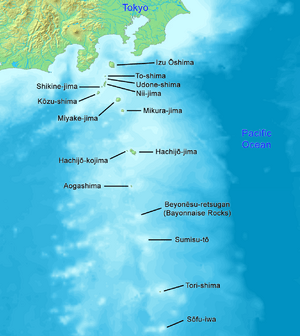Izu Islands facts for kids
The Izu Islands are a group of volcanic islands that stretch out from the Izu Peninsula of Honshū, Japan. These islands are part of Tokyo Prefecture and are organized into two towns and six villages. The biggest island is Izu Ōshima, often just called Ōshima.
Even though people often call them the "Izu Seven," there are actually more than a dozen islands and smaller islets. Nine of these islands have people living on them today.
Contents
Where are the Izu Islands?
The Izu Islands are located southeast of the Izu Peninsula on Honshū. They cover an area of about 301.56 square kilometers (116.43 square miles). In 2009, about 24,645 people lived on the nine islands.
The largest island is Izu Oshima, with 8,346 people and an area of 91.06 square kilometers (35.16 square miles). The smallest is Toshima, with 292 people and an area of 4.12 square kilometers (1.59 square miles).
The "Izu Seven" islands usually include Oshima, Toshima, Niijima, Kozujima, Miyakejima, Hachijojima, and Mikurajima. Sometimes Shikinejima and Aogashima are also added to this group.
What Makes Each Island Special?
Each of the Izu Islands has its own special features:
- Oshima is famous for its active volcano, Mount Mihara, and beautiful camellia flowers.
- Hachijojima is known for its unique culture and was once a place where people who broke rules were sent.
- Mikurajima is a great spot for watching dolphins.
- Niijima has many lovely beaches.
- Kozujima is known for its white sandy shores.
- Miyakejima experienced a big volcanic eruption in 2001.
During the Edo period in Japan, islands like Nii-jima, Miyake-jima, and Hachijō-jima were used as places to send people who had committed crimes.
All the Izu Islands are part of the Fuji-Hakone-Izu National Park. The four southernmost islands are not managed by any town or village. Torishima is an uninhabited island that is an important safe place for birds.
The Ogasawara Islands, which are also part of Tokyo, are even further south. They are a group of over 30 islands about 1,000 kilometers (620 miles) south of Tokyo.
How Do People Live on the Islands?
The main ways people make a living on the Izu Islands are through fishing, farming, and tourism. Many tourists visit the islands during the summer to enjoy the beautiful scenery.
Popular things to do include swimming, scuba diving, surfing, fishing, bird watching, and hiking.
It's easy to travel between the islands. There are cargo-passenger boats, fast jetfoils, and airplanes. All the islands where people live have harbors, and there are five airports. Smaller islands can be reached by helicopter.
There are 5 airports, 15 harbors, and 19 fishing ports. Flights from Tokyo take about 30 minutes. Boats take 7–10 hours, and jetfoils can make the trip in about two hours. Roads on the islands are important for daily life, with about 215 kilometers (134 miles) of paved main roads.
Before 1953, the islands did not have electricity. But by 1962, almost all areas had electricity.
Volcanoes and Safety
The Izu Islands are part of a long chain of volcanoes called the Izu-Bonin-Mariana Arc. This chain also includes the Izu Peninsula and Mount Fuji on the mainland.
Volcanoes are very active in this area. In 1953, 31 people died when a research ship was destroyed during an eruption of Myōjin-shō. In 2000, the island of Miyake-jima had to be evacuated because of volcanic activity and dangerous gases. People were allowed to return in February 2005, but they had to carry gas masks in case of more gas releases.
The Tokyo government has plans to keep people safe from natural disasters like tsunamis, storms, floods, and volcanic eruptions. These plans include hazard maps, evacuation guides, radios, signs, and ways to transport emergency supplies.
Images for kids
See also
 In Spanish: Islas Izu para niños
In Spanish: Islas Izu para niños





